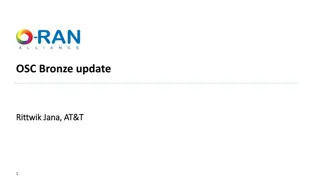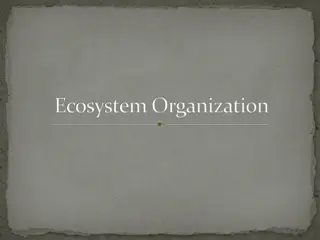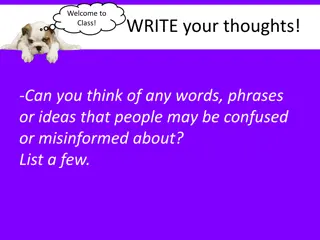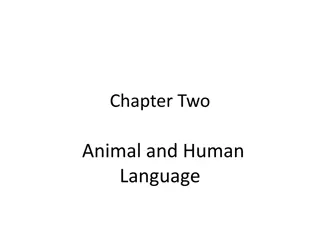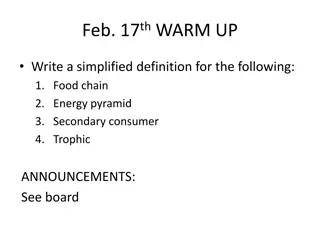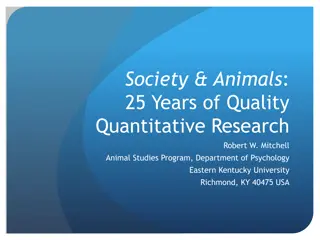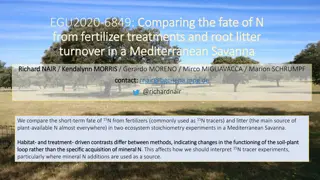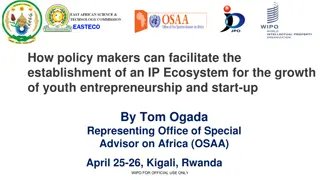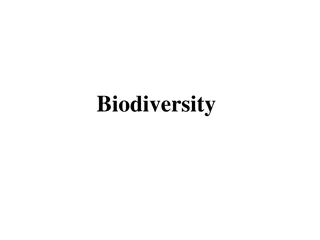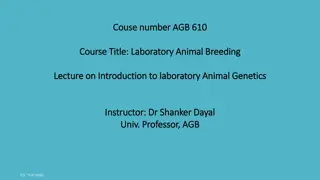Interconnected Health: Human, Animal, and Ecosystem - A Historical Perspective
Explore the intricate relationship between human health, animal plagues, and ecosystem well-being from 1400 to 1770 through zoonosis, epidemics, and early modern murrains. Delve into the concept of One Health, advocating for collaboration among healthcare professionals, veterinarians, and environmental experts to safeguard all species' health.
Download Presentation

Please find below an Image/Link to download the presentation.
The content on the website is provided AS IS for your information and personal use only. It may not be sold, licensed, or shared on other websites without obtaining consent from the author. Download presentation by click this link. If you encounter any issues during the download, it is possible that the publisher has removed the file from their server.
E N D
Presentation Transcript
Great Mortalities : Animal Plagues, Human Health, and the Medical Posthumanities, 1400-1770 M. Van der Gucht, Virgil s Georgics, 1697
Zoonosis: Infectious disease that jumps from non-human animals to humans Reverse Zoonoisis: Infectious disease that jumps from humans to non- human animals Enzootic: Disease event in nonhuman animals, usually in a particular spatio- temporal region Epizootic: Relatively more widespread outbreak, maybe across a continent, or across national borders Panzootic: Even wider spread, often worldwide. Counterpart to human pandemic Paul Garland, Zoonosis (Johns Hopkins Magazine)
The Fifth Plague of Egypt Plate 56 of the Saincte Bible. (French, ca. 1675).
Girlolamo Fracastoro, De contagion et contagiosis morbis (1546) Bernardo Ramazzini, De constitutione anni M. DC.LXXXX (1690) Giovanni Lancisi, Dissertatio Historica de Bovilla Peste (1713)
Recognizing that human health (including mental health via the human-animal bond) and ecosystem health are inextricably linked, One Health seeks to promote improve, and defend the health and well- being of all species by enhancing cooperation between physicians, veterinarians, other scientific health and environmental professionals and by promoting strengths in management to achieve these goals.
One: Zoonotic Europe, 1400-1615 Two: Contagion and Species Difference, 1712- 1770 Three: Literary Culture and Viral Chatter Conclusion: Animals Sick of the Plague Christoffel van Sichem (II), 1645-1646. Plaag van de veepest of plaag van hagel en onweer. Rijksmuseum, Amsterdam.
Some Early Modern Murrains 1407 Ireland a great murrain with foul and bad weather 1450 Ireland, loss of cattle and storms 1464 Ireland epidemic cholera, probably anthrax 1473 Ireland, loss of cattle 1480-82 European murrain; famine in France, women and children draw ploughs for loss of cattle. 1480-82 Germany and Switzerland lost a third of cattle; outbreak in Britain 1491 Ireland and Poland, epizootic 1492 Ireland, drought and epizootic 1494 Spain, murrain among wild animals 1496 Ireland harsh weather and great destruction of cows and beasts
1500 Britain (607 sheep died at Magdalen College) 1514 Italy FMD and rinderpest. Council of Venice forbids distribution of beef and veal 1517 Britain, anthrax killing cattle, ravens, and dogs 1559, 1562 Prussia, rinderpest 1566 Flanders 1581 England, Kent (13 women accused of witchcraft) 1590 Venice plague. Edicts against beef, cheese, butter, and milk 1598 Rinderpest in Germany after 2 years of starvation over Northern Europe 1598 Austria, ordered separating sick and well; forbade burning of cattle bodies 1599 Venice prohibits cattle imports from Hungary and Dalmatia
1600-1700 1604 1607 1609 1616 1618 1656 1623 1625 1630-31 1633 1665 1665-1682 1671 1679 1682 1690-91 Asia, nearly all cattle destroyed France, Lyon: laws on infected cattle Norfolk rot followed by a flood Rinderpest in Eastern and Central Europe Cattle disease devastates Italy Spain, cattle disease enzootic for 22 years Italy, sheep and cattle deaths precede bubonic plague Murrain in Scotland Hungary, cattle plague Britain, possible rinderpest Britain, mortality of cattle England, great Mortalitie before Plague of London Germany. Dead cattle ordered surrendered to executioner Anthrax and flood in Europe Austria, cattle disease Murrain in Italy, Switzerland, France, and Germany Padua, Mass die-offs of oxen, horses, pigs, bees, and silkworms Compiled from Clive Spinage, Cattle Plague: A History (2003)
Epizootic Events during Shakespeare s Lifetime
Shylock: A pound of mans flesh taken from a man/ Is not so estimable, profitable neither/ As flesh of muttons, beefs, or goats (1.3. 64-68). Lancelot: This making of Christians will raise the /price of hogs: if we grow all to be pork-eaters/ we shall not shortly have a rasher on the coals for money (3.5.19-21). Antonio: I am a tainted wether of the flock,/ Meetest for death; the weakest kind of fruit/ Drops earliest to the ground; and so let me (4.1. 113-15).
There haue beene some Beastes that haue dyed of the murren (as I haue beene credibly tolde) hee that fleade him died soone after, and he that went with it to the tanner, and the horse that carried it, and the tanner that tanned it, all these died soone therevppon, which was thought it was by the infection of the stinking skinne, but beeing true, it was a maruellous infection.(67) Leonard Mascall, The First Booke of Cattell (London, 1587).
Two: Contagion and Species Difference 1712-1770
Jan Luykens, Plaag vn de Jan Luyken (1649-1712). Dutch. veepest (Dutch, 1712.) Rijksmuseum, Amsterdam.
J. Riguaud after M. Serres, The Port of Marseille during the plague of 1720.
Experience demonstrates, that Contagions may be communicated to the same Species, by touching the Woolen, Linnen, etc. to which the Infectious Effluvia of the Diseased had adhered, tho the two Bodies should be at a very great distance; and I verily believe that more Hundreds had died from the Infection, which was carried by the Intercourse that the Cow keepers had with each other, than single ones by the original Putrifaction. Thomas Bates, , A brief account of the contagious disease which raged among the milch cowes near London, in the year 1714.
BUT if these subtile and active Particles be of that Nature, that they can penetrate the Pores of other Animals, and occasion a like Coagulation of their Blood, not only Men, but Brutes also, will be seized with a Pestilence; but this does not always very necessarily happen; because the Blood of Animals is different from humane Blood John Quincy, Of the different causes of pestilential diseases, and how they became contagious. With remarks upon the infection in France (1720)
It is true that people used all possible precaution. When any one bought a joint of meat in the market, they would not take it off the butcher s hand, but took it off the hooks themselves.
Jan Smit, God Strikes the Netherlands with rinderpest, 1745
It behoves every individual to exert, his utmost endeavors, according to his situation, to avert this impending danger of one of the most heavy calamities that can befall any European country: and more especially our own; where the luxurious habits of the common people, the difficulty of obtaining a supply of cattle from other places, and the high process of the necessaries of life, would render the effects of a scarcity of horned beasts, and consequently all other provisions, particularly grievous and intolerable (481). James Dossie, Memoirs of Agriculture (1768)
You shames of Rome! You herd of boils and plagues Plaster you o er, that you may be abhorred Farther than seen, and one infect another Against the wind a mile! (Coriolanus 1.5. 1-5)
Dejected first she hung her drooping head, Refus d her meat, and from her pasture fled; Then dull and languid seem d her plaintive eye Her breath grew noisome, and her udder dry Scorch d with perpetual thirst, short sighs she drew; Furr d was her tongue, and to her mouth it grew: Her burning nostrils putrid rheums distill d, And death s strong agonies her bowels fill d; Each limb contracted, and a groan each breath, Lost ease I wish d her, and it came in death: Cast out, infected, and abhorr d by all; See how the useful, and the beauteous fall! Not eve n her skin---when living, sleek and red, Can aught avail me, Colin, now she s dead. From William Dodd, Diggon Davy s Resolution on the Death of his Last Cow (1747)
To make amends And cleanse us of this scourge, the worst Sinner amongst us must, in sacrifice, Be offered to the gods. That is the price Their wrath demands. (56) Jean Baptiste Oudry, The Animals Fallen Sick With the Plague (1755)
lcol@illinois.edu Great Mortalities : Animal Plagues, Human Health, and the Medical Posthumanities,1400-1770 June 10, 2020
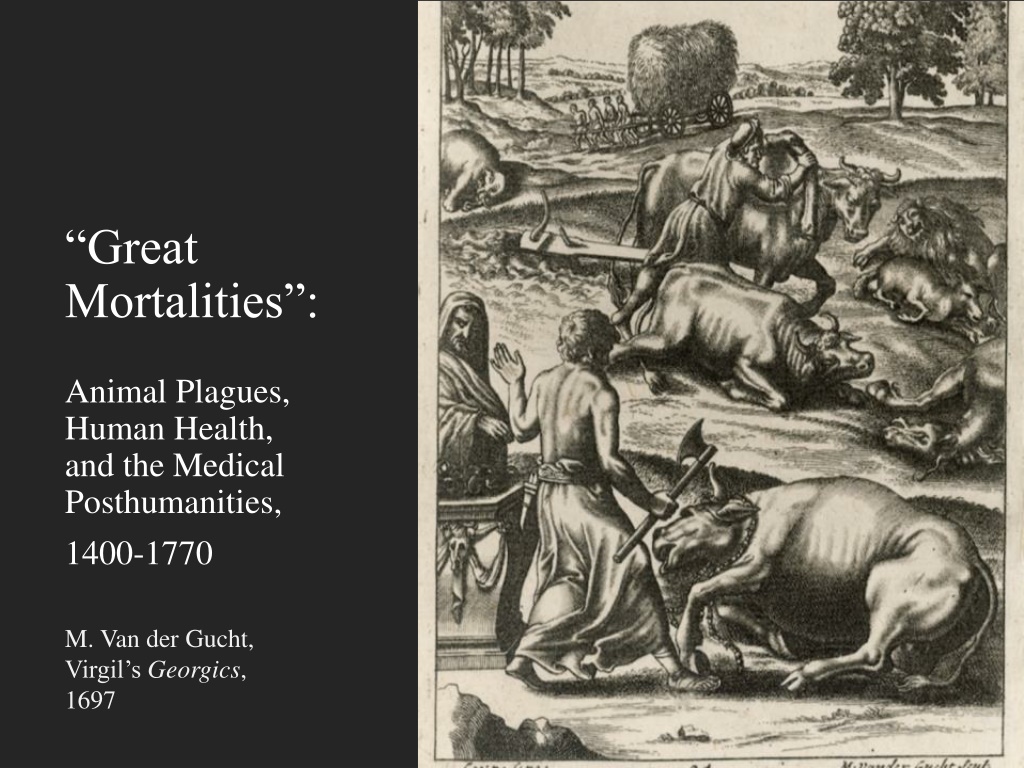
 undefined
undefined

 undefined
undefined






